Stakeholders, Partnerships, and Quality Assurance in Education Report
VerifiedAdded on 2022/08/01
|9
|2340
|358
Report
AI Summary
This report delves into the crucial roles of stakeholders and external bodies within education and training, emphasizing their impact on educational provision. It distinguishes between internal and external stakeholders, detailing the responsibilities of learners, parents, teachers, and management. The report stresses the importance of partnerships with employers and awarding bodies for enriching learning experiences and ensuring quality assurance. Furthermore, it analyzes the quality assurance and improvement cycle, including self-assessment, self-evaluation, and the quality cycle, highlighting their significance in enhancing teaching quality and student outcomes. The report also explores the role of professional development and cross-departmental collaboration in maintaining high standards and promoting continuous improvement. This report is a valuable resource for students studying professional development, offering insights into the interconnectedness of stakeholders, quality assurance, and effective educational practices.
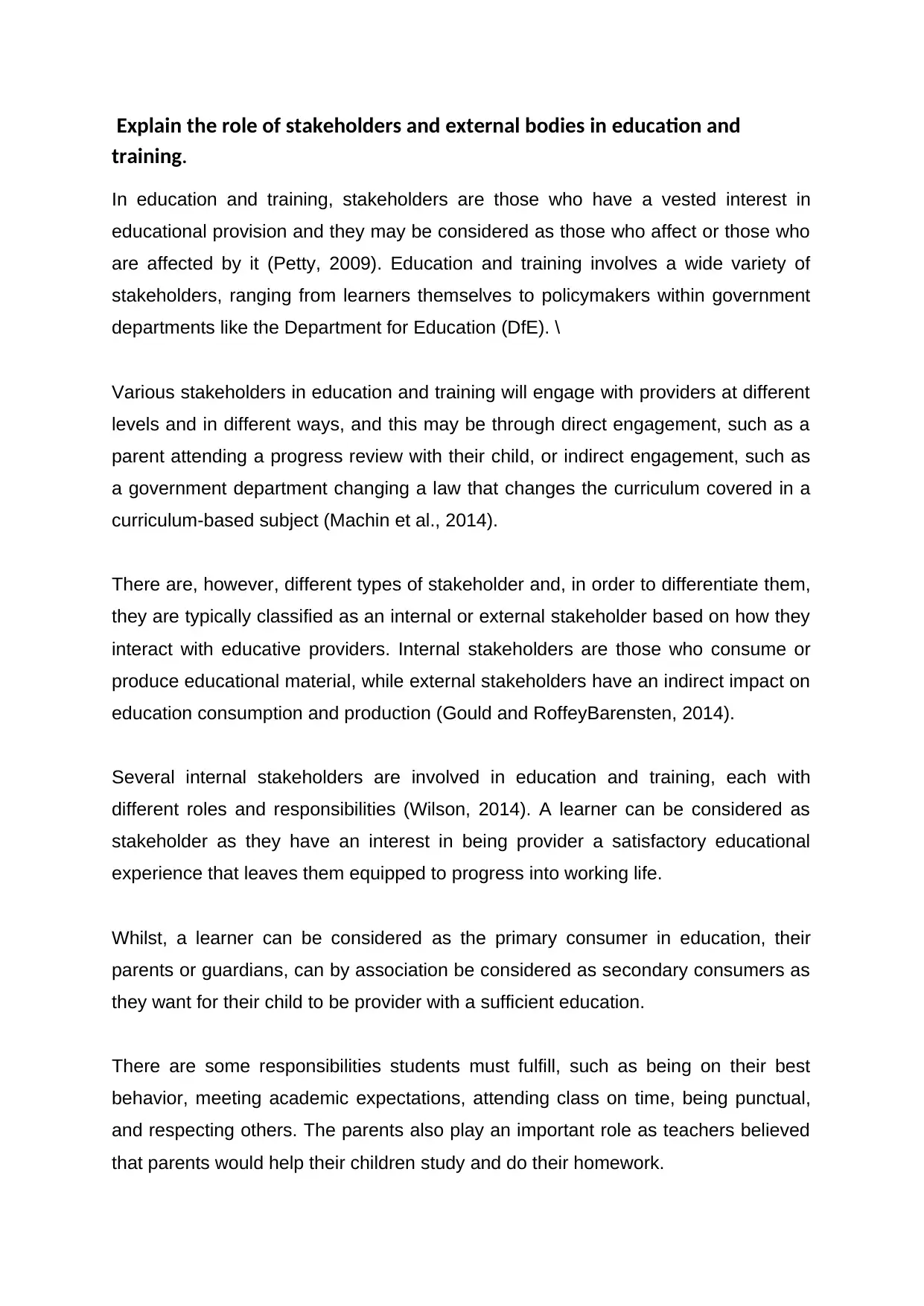
Explain the role of stakeholders and external bodies in education and
training.
In education and training, stakeholders are those who have a vested interest in
educational provision and they may be considered as those who affect or those who
are affected by it (Petty, 2009). Education and training involves a wide variety of
stakeholders, ranging from learners themselves to policymakers within government
departments like the Department for Education (DfE). \
Various stakeholders in education and training will engage with providers at different
levels and in different ways, and this may be through direct engagement, such as a
parent attending a progress review with their child, or indirect engagement, such as
a government department changing a law that changes the curriculum covered in a
curriculum-based subject (Machin et al., 2014).
There are, however, different types of stakeholder and, in order to differentiate them,
they are typically classified as an internal or external stakeholder based on how they
interact with educative providers. Internal stakeholders are those who consume or
produce educational material, while external stakeholders have an indirect impact on
education consumption and production (Gould and RoffeyBarensten, 2014).
Several internal stakeholders are involved in education and training, each with
different roles and responsibilities (Wilson, 2014). A learner can be considered as
stakeholder as they have an interest in being provider a satisfactory educational
experience that leaves them equipped to progress into working life.
Whilst, a learner can be considered as the primary consumer in education, their
parents or guardians, can by association be considered as secondary consumers as
they want for their child to be provider with a sufficient education.
There are some responsibilities students must fulfill, such as being on their best
behavior, meeting academic expectations, attending class on time, being punctual,
and respecting others. The parents also play an important role as teachers believed
that parents would help their children study and do their homework.
training.
In education and training, stakeholders are those who have a vested interest in
educational provision and they may be considered as those who affect or those who
are affected by it (Petty, 2009). Education and training involves a wide variety of
stakeholders, ranging from learners themselves to policymakers within government
departments like the Department for Education (DfE). \
Various stakeholders in education and training will engage with providers at different
levels and in different ways, and this may be through direct engagement, such as a
parent attending a progress review with their child, or indirect engagement, such as
a government department changing a law that changes the curriculum covered in a
curriculum-based subject (Machin et al., 2014).
There are, however, different types of stakeholder and, in order to differentiate them,
they are typically classified as an internal or external stakeholder based on how they
interact with educative providers. Internal stakeholders are those who consume or
produce educational material, while external stakeholders have an indirect impact on
education consumption and production (Gould and RoffeyBarensten, 2014).
Several internal stakeholders are involved in education and training, each with
different roles and responsibilities (Wilson, 2014). A learner can be considered as
stakeholder as they have an interest in being provider a satisfactory educational
experience that leaves them equipped to progress into working life.
Whilst, a learner can be considered as the primary consumer in education, their
parents or guardians, can by association be considered as secondary consumers as
they want for their child to be provider with a sufficient education.
There are some responsibilities students must fulfill, such as being on their best
behavior, meeting academic expectations, attending class on time, being punctual,
and respecting others. The parents also play an important role as teachers believed
that parents would help their children study and do their homework.
Paraphrase This Document
Need a fresh take? Get an instant paraphrase of this document with our AI Paraphraser
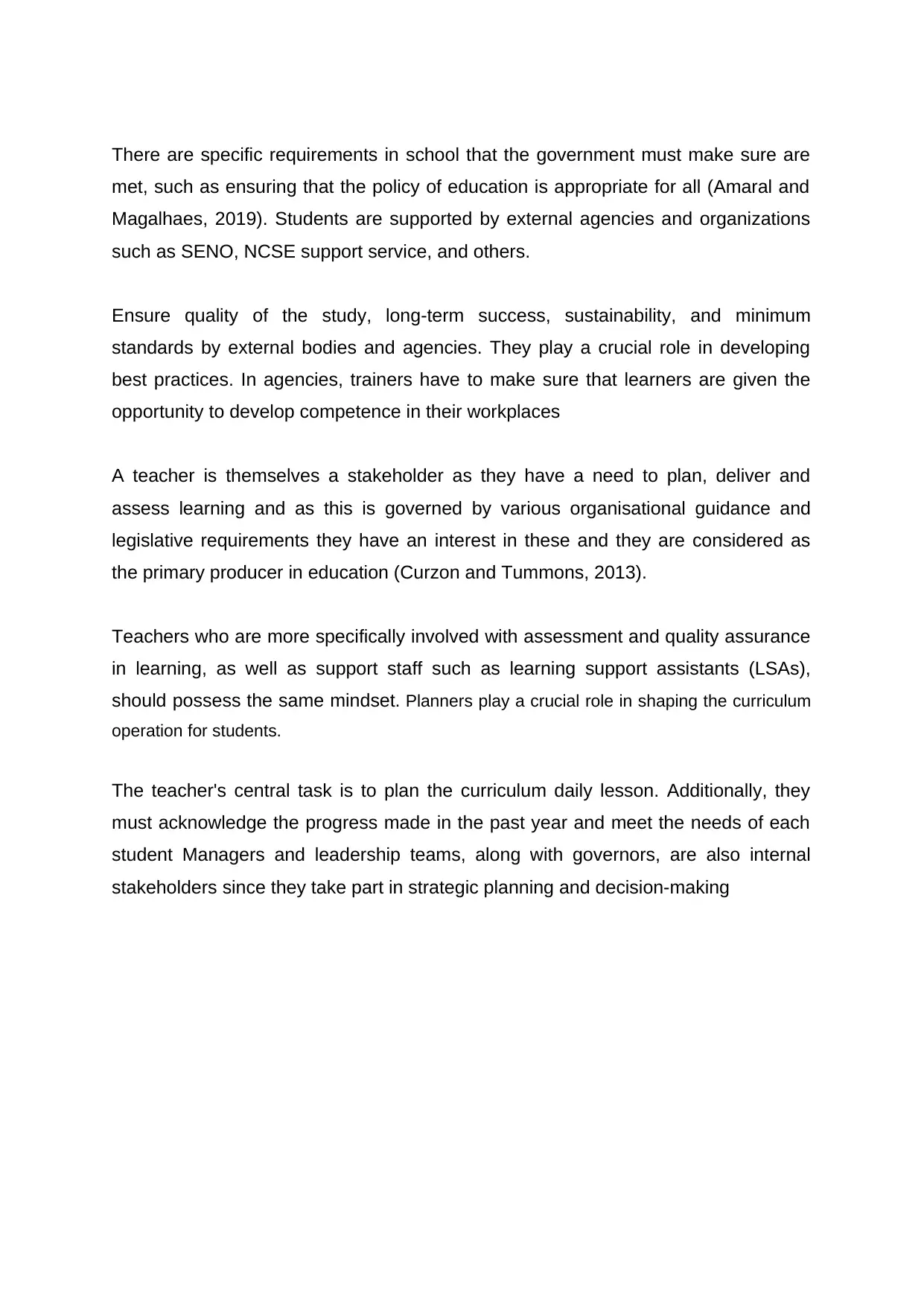
There are specific requirements in school that the government must make sure are
met, such as ensuring that the policy of education is appropriate for all (Amaral and
Magalhaes, 2019). Students are supported by external agencies and organizations
such as SENO, NCSE support service, and others.
Ensure quality of the study, long-term success, sustainability, and minimum
standards by external bodies and agencies. They play a crucial role in developing
best practices. In agencies, trainers have to make sure that learners are given the
opportunity to develop competence in their workplaces
A teacher is themselves a stakeholder as they have a need to plan, deliver and
assess learning and as this is governed by various organisational guidance and
legislative requirements they have an interest in these and they are considered as
the primary producer in education (Curzon and Tummons, 2013).
Teachers who are more specifically involved with assessment and quality assurance
in learning, as well as support staff such as learning support assistants (LSAs),
should possess the same mindset. Planners play a crucial role in shaping the curriculum
operation for students.
The teacher's central task is to plan the curriculum daily lesson. Additionally, they
must acknowledge the progress made in the past year and meet the needs of each
student Managers and leadership teams, along with governors, are also internal
stakeholders since they take part in strategic planning and decision-making
met, such as ensuring that the policy of education is appropriate for all (Amaral and
Magalhaes, 2019). Students are supported by external agencies and organizations
such as SENO, NCSE support service, and others.
Ensure quality of the study, long-term success, sustainability, and minimum
standards by external bodies and agencies. They play a crucial role in developing
best practices. In agencies, trainers have to make sure that learners are given the
opportunity to develop competence in their workplaces
A teacher is themselves a stakeholder as they have a need to plan, deliver and
assess learning and as this is governed by various organisational guidance and
legislative requirements they have an interest in these and they are considered as
the primary producer in education (Curzon and Tummons, 2013).
Teachers who are more specifically involved with assessment and quality assurance
in learning, as well as support staff such as learning support assistants (LSAs),
should possess the same mindset. Planners play a crucial role in shaping the curriculum
operation for students.
The teacher's central task is to plan the curriculum daily lesson. Additionally, they
must acknowledge the progress made in the past year and meet the needs of each
student Managers and leadership teams, along with governors, are also internal
stakeholders since they take part in strategic planning and decision-making
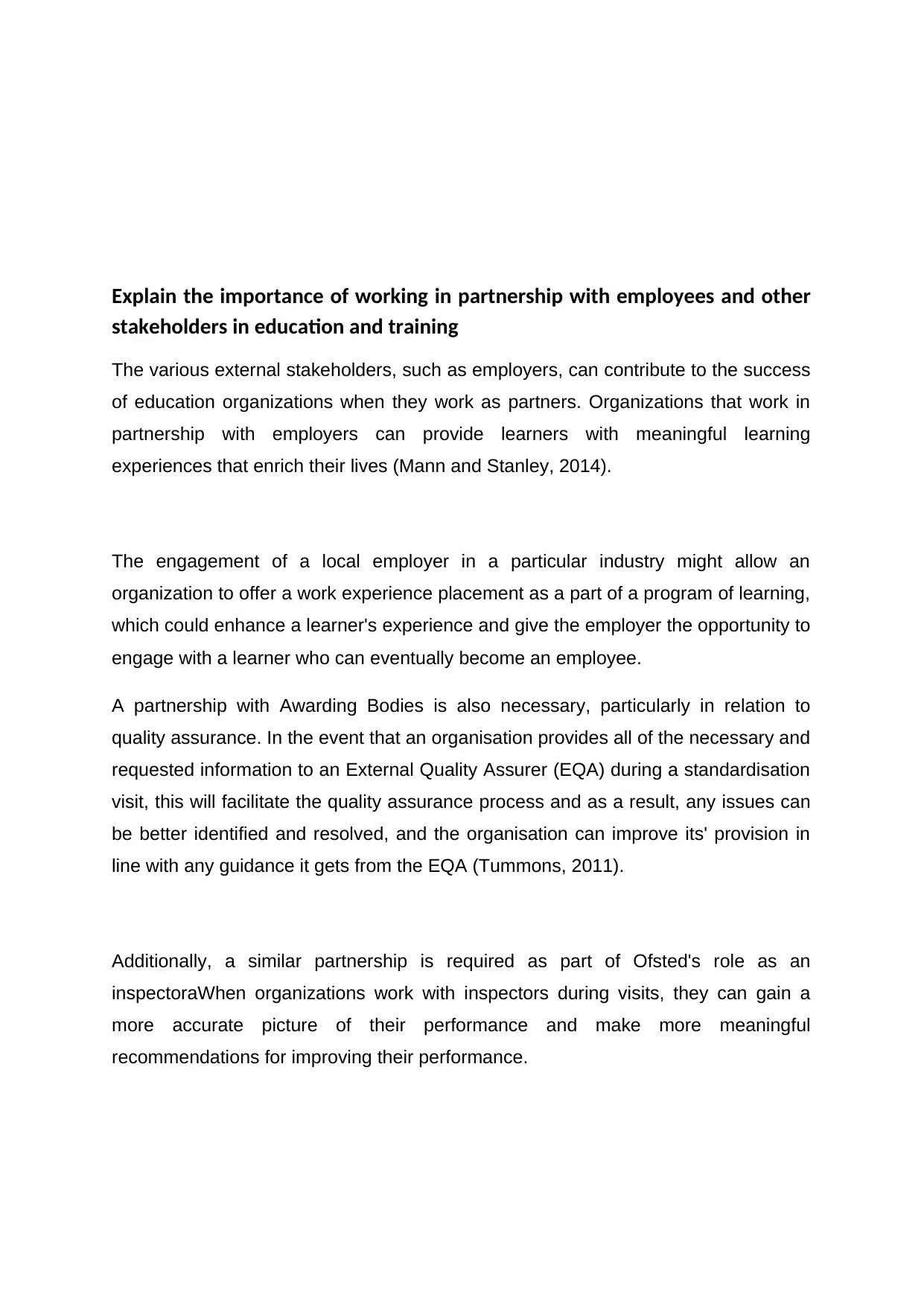
Explain the importance of working in partnership with employees and other
stakeholders in education and training
The various external stakeholders, such as employers, can contribute to the success
of education organizations when they work as partners. Organizations that work in
partnership with employers can provide learners with meaningful learning
experiences that enrich their lives (Mann and Stanley, 2014).
The engagement of a local employer in a particular industry might allow an
organization to offer a work experience placement as a part of a program of learning,
which could enhance a learner's experience and give the employer the opportunity to
engage with a learner who can eventually become an employee.
A partnership with Awarding Bodies is also necessary, particularly in relation to
quality assurance. In the event that an organisation provides all of the necessary and
requested information to an External Quality Assurer (EQA) during a standardisation
visit, this will facilitate the quality assurance process and as a result, any issues can
be better identified and resolved, and the organisation can improve its' provision in
line with any guidance it gets from the EQA (Tummons, 2011).
Additionally, a similar partnership is required as part of Ofsted's role as an
inspectoraWhen organizations work with inspectors during visits, they can gain a
more accurate picture of their performance and make more meaningful
recommendations for improving their performance.
stakeholders in education and training
The various external stakeholders, such as employers, can contribute to the success
of education organizations when they work as partners. Organizations that work in
partnership with employers can provide learners with meaningful learning
experiences that enrich their lives (Mann and Stanley, 2014).
The engagement of a local employer in a particular industry might allow an
organization to offer a work experience placement as a part of a program of learning,
which could enhance a learner's experience and give the employer the opportunity to
engage with a learner who can eventually become an employee.
A partnership with Awarding Bodies is also necessary, particularly in relation to
quality assurance. In the event that an organisation provides all of the necessary and
requested information to an External Quality Assurer (EQA) during a standardisation
visit, this will facilitate the quality assurance process and as a result, any issues can
be better identified and resolved, and the organisation can improve its' provision in
line with any guidance it gets from the EQA (Tummons, 2011).
Additionally, a similar partnership is required as part of Ofsted's role as an
inspectoraWhen organizations work with inspectors during visits, they can gain a
more accurate picture of their performance and make more meaningful
recommendations for improving their performance.
⊘ This is a preview!⊘
Do you want full access?
Subscribe today to unlock all pages.

Trusted by 1+ million students worldwide
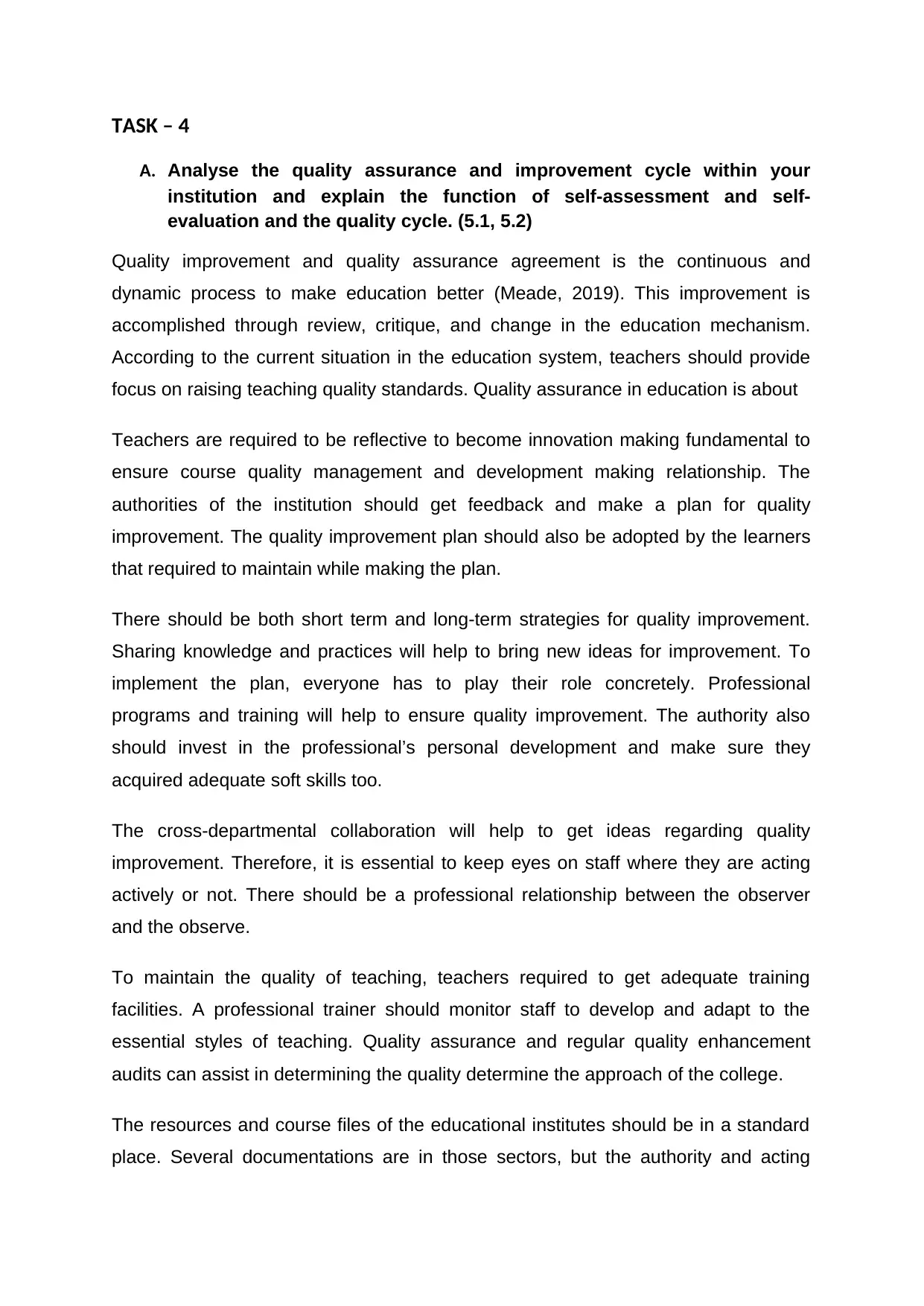
TASK – 4
A. Analyse the quality assurance and improvement cycle within your
institution and explain the function of self-assessment and self-
evaluation and the quality cycle. (5.1, 5.2)
Quality improvement and quality assurance agreement is the continuous and
dynamic process to make education better (Meade, 2019). This improvement is
accomplished through review, critique, and change in the education mechanism.
According to the current situation in the education system, teachers should provide
focus on raising teaching quality standards. Quality assurance in education is about
Teachers are required to be reflective to become innovation making fundamental to
ensure course quality management and development making relationship. The
authorities of the institution should get feedback and make a plan for quality
improvement. The quality improvement plan should also be adopted by the learners
that required to maintain while making the plan.
There should be both short term and long-term strategies for quality improvement.
Sharing knowledge and practices will help to bring new ideas for improvement. To
implement the plan, everyone has to play their role concretely. Professional
programs and training will help to ensure quality improvement. The authority also
should invest in the professional’s personal development and make sure they
acquired adequate soft skills too.
The cross-departmental collaboration will help to get ideas regarding quality
improvement. Therefore, it is essential to keep eyes on staff where they are acting
actively or not. There should be a professional relationship between the observer
and the observe.
To maintain the quality of teaching, teachers required to get adequate training
facilities. A professional trainer should monitor staff to develop and adapt to the
essential styles of teaching. Quality assurance and regular quality enhancement
audits can assist in determining the quality determine the approach of the college.
The resources and course files of the educational institutes should be in a standard
place. Several documentations are in those sectors, but the authority and acting
A. Analyse the quality assurance and improvement cycle within your
institution and explain the function of self-assessment and self-
evaluation and the quality cycle. (5.1, 5.2)
Quality improvement and quality assurance agreement is the continuous and
dynamic process to make education better (Meade, 2019). This improvement is
accomplished through review, critique, and change in the education mechanism.
According to the current situation in the education system, teachers should provide
focus on raising teaching quality standards. Quality assurance in education is about
Teachers are required to be reflective to become innovation making fundamental to
ensure course quality management and development making relationship. The
authorities of the institution should get feedback and make a plan for quality
improvement. The quality improvement plan should also be adopted by the learners
that required to maintain while making the plan.
There should be both short term and long-term strategies for quality improvement.
Sharing knowledge and practices will help to bring new ideas for improvement. To
implement the plan, everyone has to play their role concretely. Professional
programs and training will help to ensure quality improvement. The authority also
should invest in the professional’s personal development and make sure they
acquired adequate soft skills too.
The cross-departmental collaboration will help to get ideas regarding quality
improvement. Therefore, it is essential to keep eyes on staff where they are acting
actively or not. There should be a professional relationship between the observer
and the observe.
To maintain the quality of teaching, teachers required to get adequate training
facilities. A professional trainer should monitor staff to develop and adapt to the
essential styles of teaching. Quality assurance and regular quality enhancement
audits can assist in determining the quality determine the approach of the college.
The resources and course files of the educational institutes should be in a standard
place. Several documentations are in those sectors, but the authority and acting
Paraphrase This Document
Need a fresh take? Get an instant paraphrase of this document with our AI Paraphraser
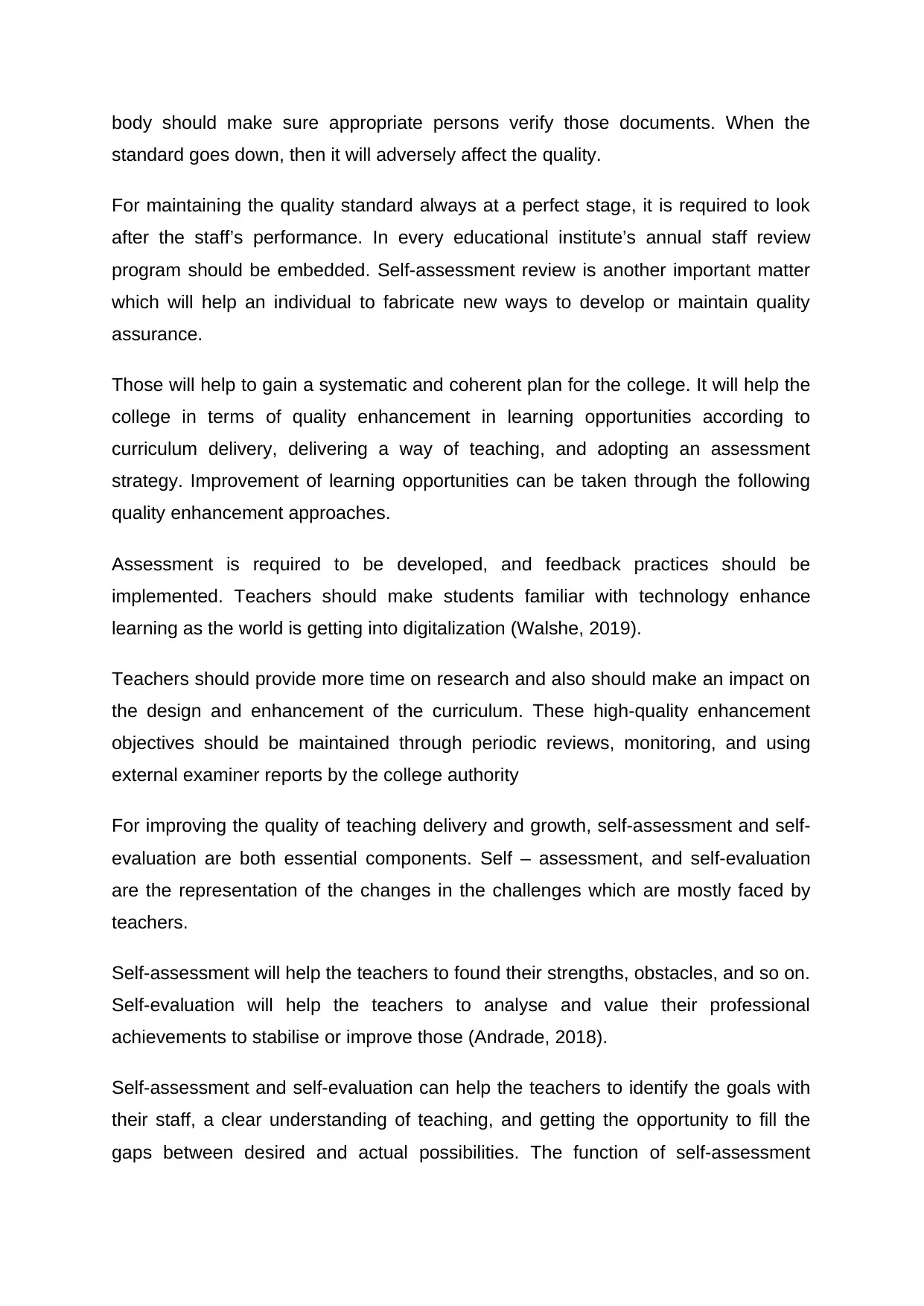
body should make sure appropriate persons verify those documents. When the
standard goes down, then it will adversely affect the quality.
For maintaining the quality standard always at a perfect stage, it is required to look
after the staff’s performance. In every educational institute’s annual staff review
program should be embedded. Self-assessment review is another important matter
which will help an individual to fabricate new ways to develop or maintain quality
assurance.
Those will help to gain a systematic and coherent plan for the college. It will help the
college in terms of quality enhancement in learning opportunities according to
curriculum delivery, delivering a way of teaching, and adopting an assessment
strategy. Improvement of learning opportunities can be taken through the following
quality enhancement approaches.
Assessment is required to be developed, and feedback practices should be
implemented. Teachers should make students familiar with technology enhance
learning as the world is getting into digitalization (Walshe, 2019).
Teachers should provide more time on research and also should make an impact on
the design and enhancement of the curriculum. These high-quality enhancement
objectives should be maintained through periodic reviews, monitoring, and using
external examiner reports by the college authority
For improving the quality of teaching delivery and growth, self-assessment and self-
evaluation are both essential components. Self – assessment, and self-evaluation
are the representation of the changes in the challenges which are mostly faced by
teachers.
Self-assessment will help the teachers to found their strengths, obstacles, and so on.
Self-evaluation will help the teachers to analyse and value their professional
achievements to stabilise or improve those (Andrade, 2018).
Self-assessment and self-evaluation can help the teachers to identify the goals with
their staff, a clear understanding of teaching, and getting the opportunity to fill the
gaps between desired and actual possibilities. The function of self-assessment
standard goes down, then it will adversely affect the quality.
For maintaining the quality standard always at a perfect stage, it is required to look
after the staff’s performance. In every educational institute’s annual staff review
program should be embedded. Self-assessment review is another important matter
which will help an individual to fabricate new ways to develop or maintain quality
assurance.
Those will help to gain a systematic and coherent plan for the college. It will help the
college in terms of quality enhancement in learning opportunities according to
curriculum delivery, delivering a way of teaching, and adopting an assessment
strategy. Improvement of learning opportunities can be taken through the following
quality enhancement approaches.
Assessment is required to be developed, and feedback practices should be
implemented. Teachers should make students familiar with technology enhance
learning as the world is getting into digitalization (Walshe, 2019).
Teachers should provide more time on research and also should make an impact on
the design and enhancement of the curriculum. These high-quality enhancement
objectives should be maintained through periodic reviews, monitoring, and using
external examiner reports by the college authority
For improving the quality of teaching delivery and growth, self-assessment and self-
evaluation are both essential components. Self – assessment, and self-evaluation
are the representation of the changes in the challenges which are mostly faced by
teachers.
Self-assessment will help the teachers to found their strengths, obstacles, and so on.
Self-evaluation will help the teachers to analyse and value their professional
achievements to stabilise or improve those (Andrade, 2018).
Self-assessment and self-evaluation can help the teachers to identify the goals with
their staff, a clear understanding of teaching, and getting the opportunity to fill the
gaps between desired and actual possibilities. The function of self-assessment
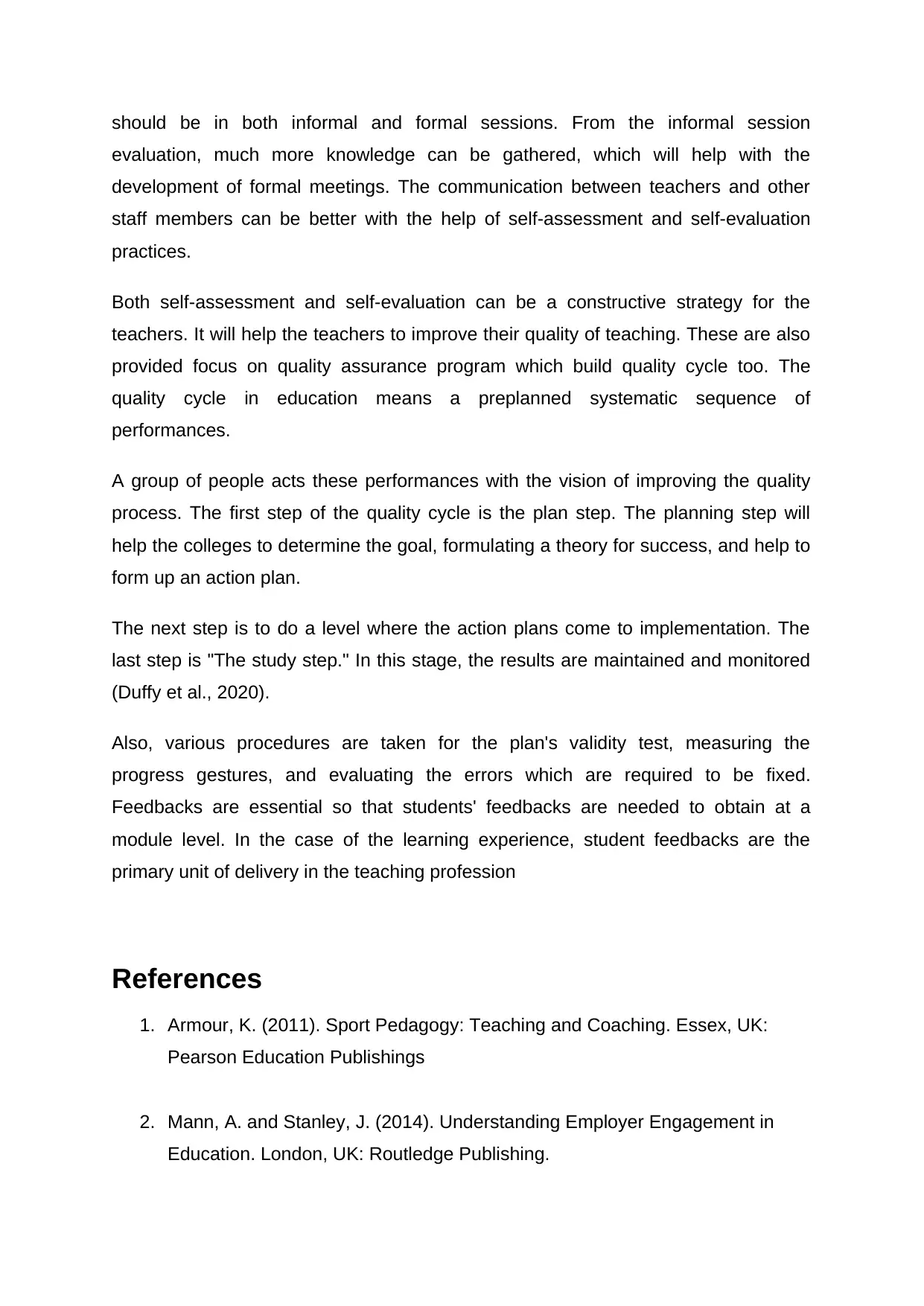
should be in both informal and formal sessions. From the informal session
evaluation, much more knowledge can be gathered, which will help with the
development of formal meetings. The communication between teachers and other
staff members can be better with the help of self-assessment and self-evaluation
practices.
Both self-assessment and self-evaluation can be a constructive strategy for the
teachers. It will help the teachers to improve their quality of teaching. These are also
provided focus on quality assurance program which build quality cycle too. The
quality cycle in education means a preplanned systematic sequence of
performances.
A group of people acts these performances with the vision of improving the quality
process. The first step of the quality cycle is the plan step. The planning step will
help the colleges to determine the goal, formulating a theory for success, and help to
form up an action plan.
The next step is to do a level where the action plans come to implementation. The
last step is "The study step." In this stage, the results are maintained and monitored
(Duffy et al., 2020).
Also, various procedures are taken for the plan's validity test, measuring the
progress gestures, and evaluating the errors which are required to be fixed.
Feedbacks are essential so that students' feedbacks are needed to obtain at a
module level. In the case of the learning experience, student feedbacks are the
primary unit of delivery in the teaching profession
References
1. Armour, K. (2011). Sport Pedagogy: Teaching and Coaching. Essex, UK:
Pearson Education Publishings
2. Mann, A. and Stanley, J. (2014). Understanding Employer Engagement in
Education. London, UK: Routledge Publishing.
evaluation, much more knowledge can be gathered, which will help with the
development of formal meetings. The communication between teachers and other
staff members can be better with the help of self-assessment and self-evaluation
practices.
Both self-assessment and self-evaluation can be a constructive strategy for the
teachers. It will help the teachers to improve their quality of teaching. These are also
provided focus on quality assurance program which build quality cycle too. The
quality cycle in education means a preplanned systematic sequence of
performances.
A group of people acts these performances with the vision of improving the quality
process. The first step of the quality cycle is the plan step. The planning step will
help the colleges to determine the goal, formulating a theory for success, and help to
form up an action plan.
The next step is to do a level where the action plans come to implementation. The
last step is "The study step." In this stage, the results are maintained and monitored
(Duffy et al., 2020).
Also, various procedures are taken for the plan's validity test, measuring the
progress gestures, and evaluating the errors which are required to be fixed.
Feedbacks are essential so that students' feedbacks are needed to obtain at a
module level. In the case of the learning experience, student feedbacks are the
primary unit of delivery in the teaching profession
References
1. Armour, K. (2011). Sport Pedagogy: Teaching and Coaching. Essex, UK:
Pearson Education Publishings
2. Mann, A. and Stanley, J. (2014). Understanding Employer Engagement in
Education. London, UK: Routledge Publishing.
⊘ This is a preview!⊘
Do you want full access?
Subscribe today to unlock all pages.

Trusted by 1+ million students worldwide
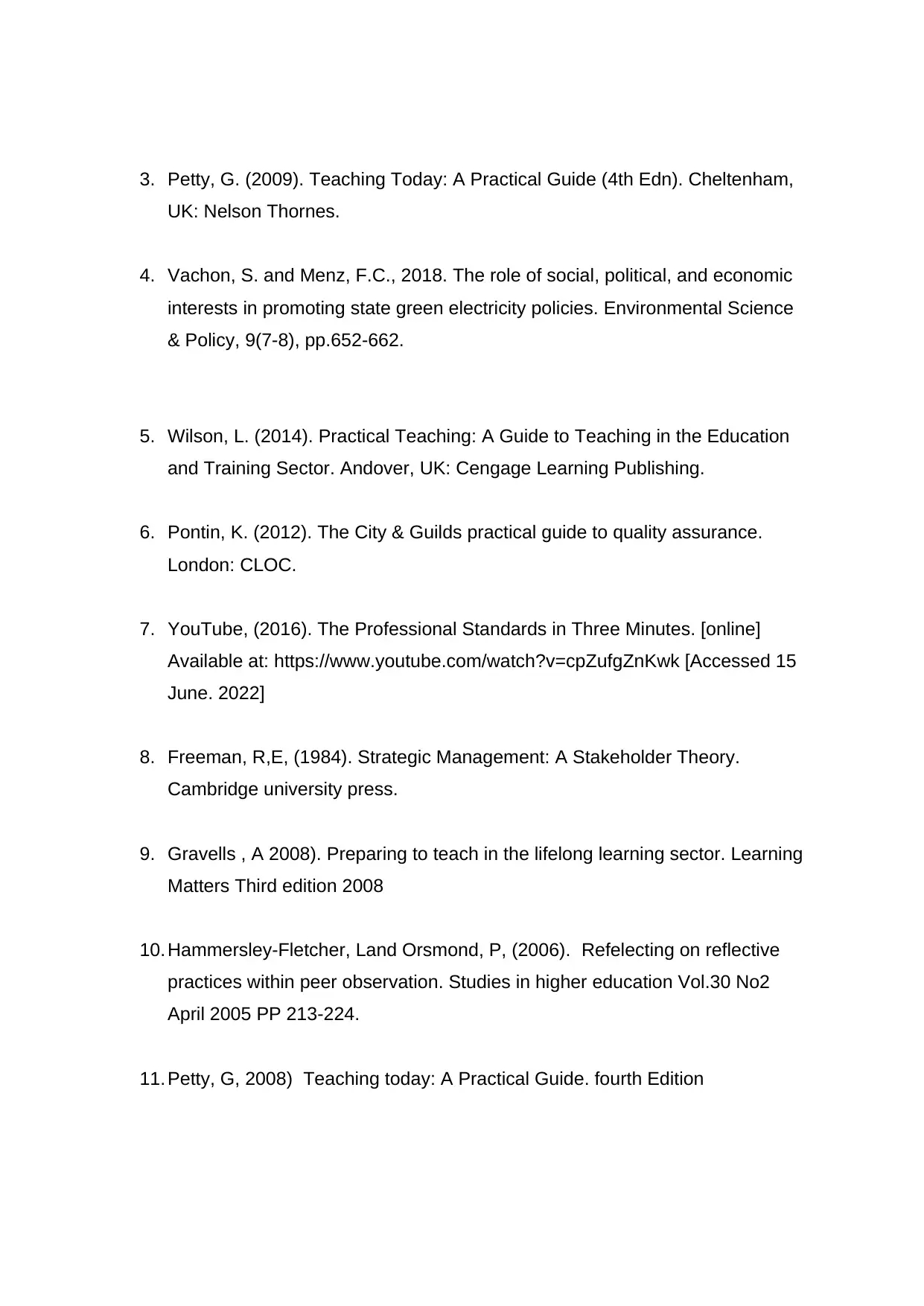
3. Petty, G. (2009). Teaching Today: A Practical Guide (4th Edn). Cheltenham,
UK: Nelson Thornes.
4. Vachon, S. and Menz, F.C., 2018. The role of social, political, and economic
interests in promoting state green electricity policies. Environmental Science
& Policy, 9(7-8), pp.652-662.
5. Wilson, L. (2014). Practical Teaching: A Guide to Teaching in the Education
and Training Sector. Andover, UK: Cengage Learning Publishing.
6. Pontin, K. (2012). The City & Guilds practical guide to quality assurance.
London: CLOC.
7. YouTube, (2016). The Professional Standards in Three Minutes. [online]
Available at: https://www.youtube.com/watch?v=cpZufgZnKwk [Accessed 15
June. 2022]
8. Freeman, R,E, (1984). Strategic Management: A Stakeholder Theory.
Cambridge university press.
9. Gravells , A 2008). Preparing to teach in the lifelong learning sector. Learning
Matters Third edition 2008
10. Hammersley-Fletcher, Land Orsmond, P, (2006). Refelecting on reflective
practices within peer observation. Studies in higher education Vol.30 No2
April 2005 PP 213-224.
11. Petty, G, 2008) Teaching today: A Practical Guide. fourth Edition
UK: Nelson Thornes.
4. Vachon, S. and Menz, F.C., 2018. The role of social, political, and economic
interests in promoting state green electricity policies. Environmental Science
& Policy, 9(7-8), pp.652-662.
5. Wilson, L. (2014). Practical Teaching: A Guide to Teaching in the Education
and Training Sector. Andover, UK: Cengage Learning Publishing.
6. Pontin, K. (2012). The City & Guilds practical guide to quality assurance.
London: CLOC.
7. YouTube, (2016). The Professional Standards in Three Minutes. [online]
Available at: https://www.youtube.com/watch?v=cpZufgZnKwk [Accessed 15
June. 2022]
8. Freeman, R,E, (1984). Strategic Management: A Stakeholder Theory.
Cambridge university press.
9. Gravells , A 2008). Preparing to teach in the lifelong learning sector. Learning
Matters Third edition 2008
10. Hammersley-Fletcher, Land Orsmond, P, (2006). Refelecting on reflective
practices within peer observation. Studies in higher education Vol.30 No2
April 2005 PP 213-224.
11. Petty, G, 2008) Teaching today: A Practical Guide. fourth Edition
Paraphrase This Document
Need a fresh take? Get an instant paraphrase of this document with our AI Paraphraser
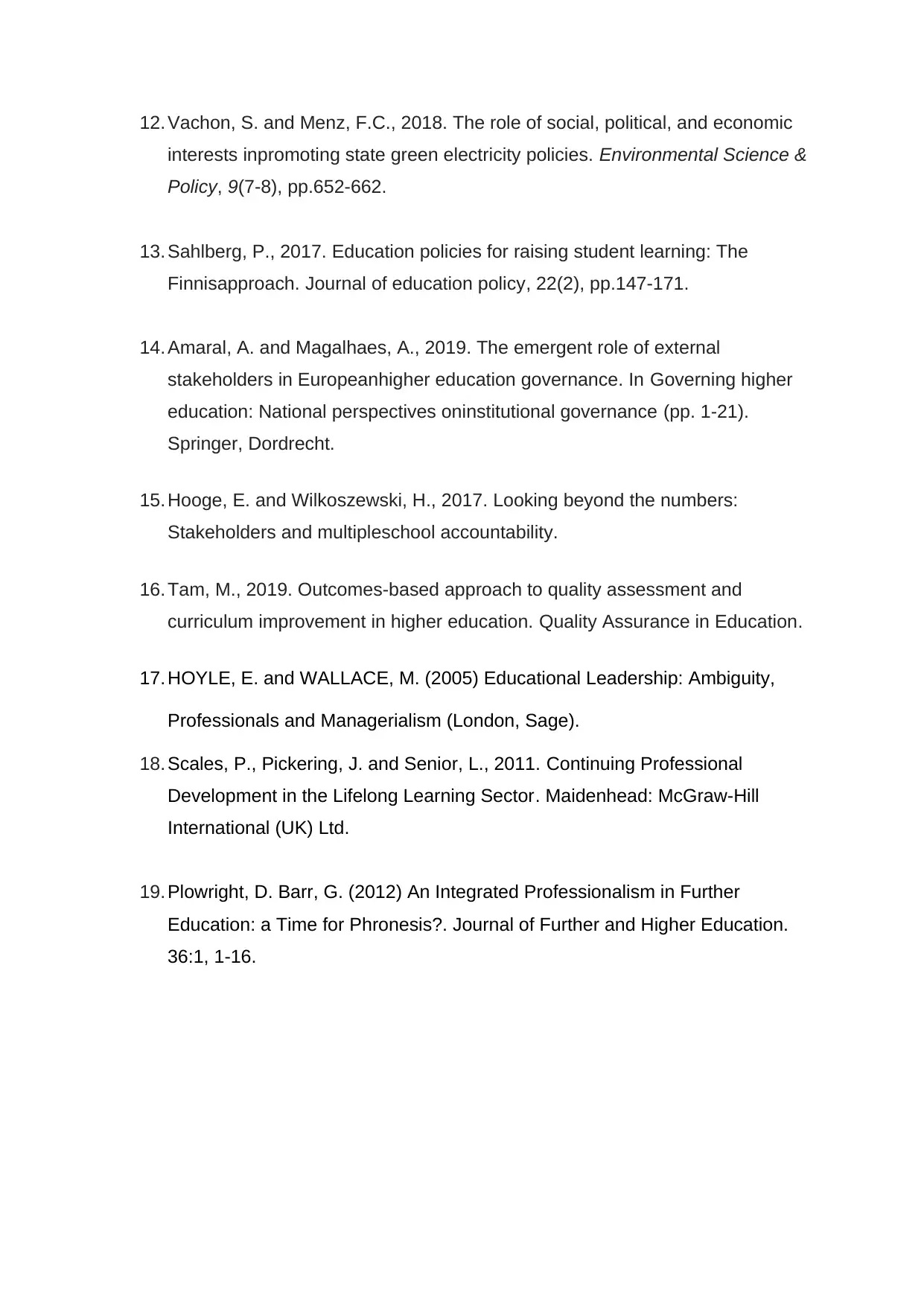
12. Vachon, S. and Menz, F.C., 2018. The role of social, political, and economic
interests inpromoting state green electricity policies. Environmental Science &
Policy, 9(7-8), pp.652-662.
13. Sahlberg, P., 2017. Education policies for raising student learning: The
Finnisapproach. Journal of education policy, 22(2), pp.147-171.
14. Amaral, A. and Magalhaes, A., 2019. The emergent role of external
stakeholders in Europeanhigher education governance. In Governing higher
education: National perspectives oninstitutional governance (pp. 1-21).
Springer, Dordrecht.
15. Hooge, E. and Wilkoszewski, H., 2017. Looking beyond the numbers:
Stakeholders and multipleschool accountability.
16. Tam, M., 2019. Outcomes-based approach to quality assessment and
curriculum improvement in higher education. Quality Assurance in Education.
17. HOYLE, E. and WALLACE, M. (2005) Educational Leadership: Ambiguity,
Professionals and Managerialism (London, Sage).
18. Scales, P., Pickering, J. and Senior, L., 2011. Continuing Professional
Development in the Lifelong Learning Sector. Maidenhead: McGraw-Hill
International (UK) Ltd.
19. Plowright, D. Barr, G. (2012) An Integrated Professionalism in Further
Education: a Time for Phronesis?. Journal of Further and Higher Education.
36:1, 1-16.
interests inpromoting state green electricity policies. Environmental Science &
Policy, 9(7-8), pp.652-662.
13. Sahlberg, P., 2017. Education policies for raising student learning: The
Finnisapproach. Journal of education policy, 22(2), pp.147-171.
14. Amaral, A. and Magalhaes, A., 2019. The emergent role of external
stakeholders in Europeanhigher education governance. In Governing higher
education: National perspectives oninstitutional governance (pp. 1-21).
Springer, Dordrecht.
15. Hooge, E. and Wilkoszewski, H., 2017. Looking beyond the numbers:
Stakeholders and multipleschool accountability.
16. Tam, M., 2019. Outcomes-based approach to quality assessment and
curriculum improvement in higher education. Quality Assurance in Education.
17. HOYLE, E. and WALLACE, M. (2005) Educational Leadership: Ambiguity,
Professionals and Managerialism (London, Sage).
18. Scales, P., Pickering, J. and Senior, L., 2011. Continuing Professional
Development in the Lifelong Learning Sector. Maidenhead: McGraw-Hill
International (UK) Ltd.
19. Plowright, D. Barr, G. (2012) An Integrated Professionalism in Further
Education: a Time for Phronesis?. Journal of Further and Higher Education.
36:1, 1-16.
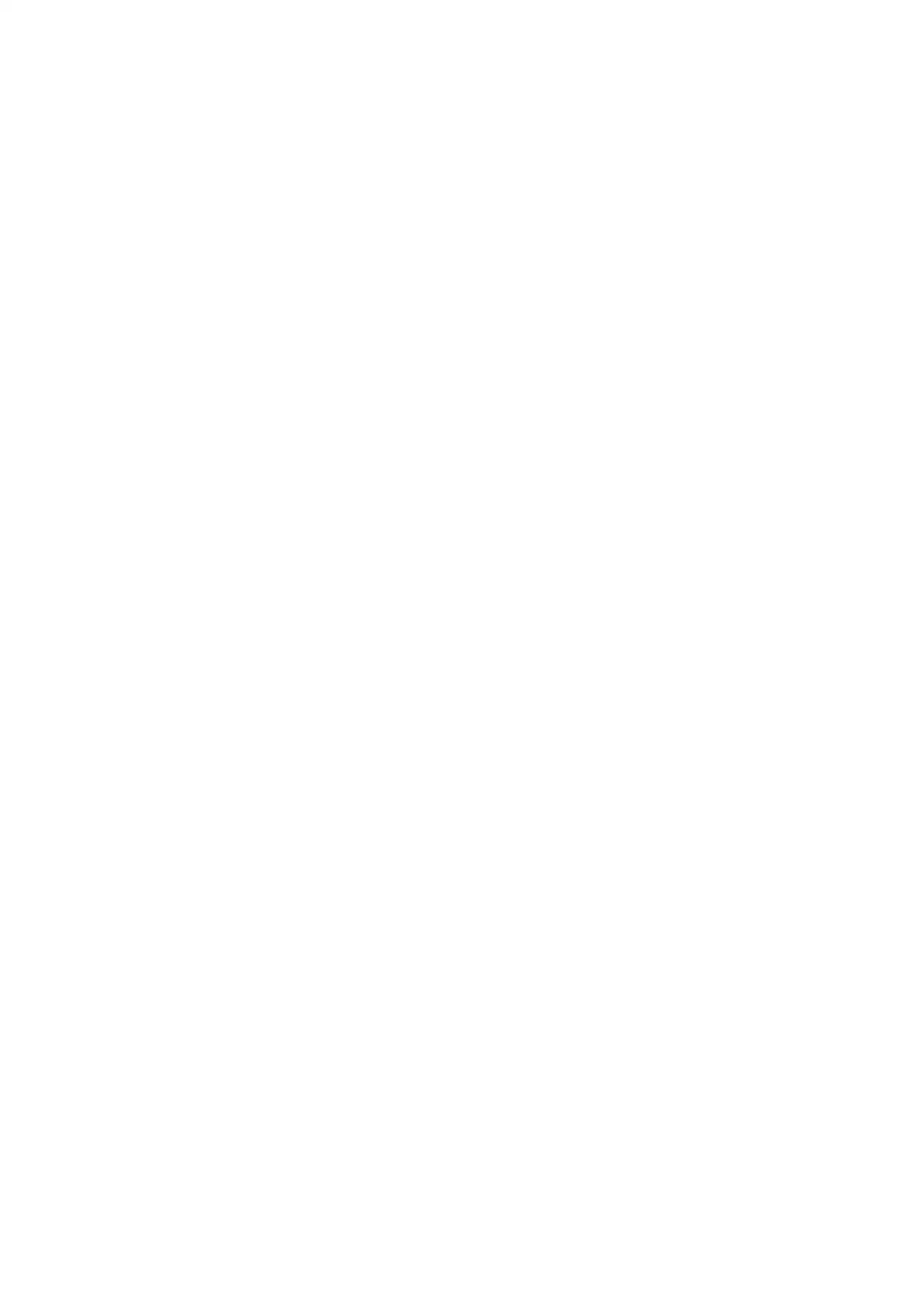
⊘ This is a preview!⊘
Do you want full access?
Subscribe today to unlock all pages.

Trusted by 1+ million students worldwide
1 out of 9
Related Documents
Your All-in-One AI-Powered Toolkit for Academic Success.
+13062052269
info@desklib.com
Available 24*7 on WhatsApp / Email
![[object Object]](/_next/static/media/star-bottom.7253800d.svg)
Unlock your academic potential
Copyright © 2020–2025 A2Z Services. All Rights Reserved. Developed and managed by ZUCOL.




